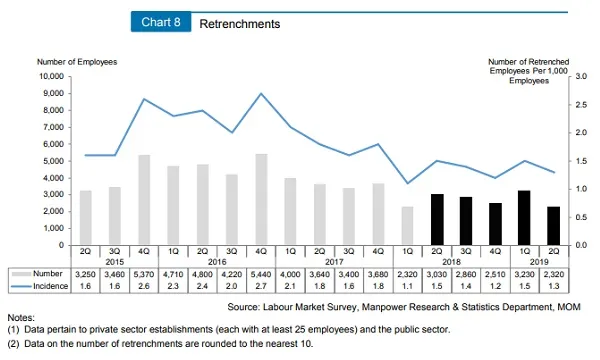
Retrenchments fell to 2,320 in Q2
Retrenchments amongst production and related workers shrank to 340 from 1,350.
Retrenchments dropped to 2,320 in Q2 2019 both QoQ (3,230) and YoY (3,030), according to a report by the Ministry of Manpower (MOM).
The decline was particularly observed as the number of retrenchments in production and related works fell from 1,350 to 340 and also dipped from 440 to 290 for clerical, sales and service workers.
On the other hand, layoffs rose amongst professionals, managers, executives and technicians (PMETs) to 1,680 from 1,440. This makes up 77% of locals retrenched.
Also read: Retrenchments grew to 3,230 in Q1 over manufacturing cutbacks
About 72% of retrenchments in the quarter were from the services sector. Amongst them, the biggest proportion come from wholesale trade (19%), followed by financial services (17%) then professional services (11%).

In the first half of the year, total employment excluding foreign domestic workers grew by 16,900, from 6,900 YoY, whilst the increase in local employment dropped 5,300 from 6,500 the previous year.
Total employment grew by 6,200 in Q2, but has slowed down over the past three quarters. The bulk of the growth came from the service sector with 5,400, though this was at its lowest since Q3 2016.
Employment climbed in professional services by 2,100, information and communications by 2,000, community, social and personal services by 1,900, and financial and insurance services by 1,600. However, retail trade saw a decline of 2,900.
Construction sector employment expanded by 2,700 whilst manufacturing posted another contraction for the third consecutive time by 1,500.
On the other hand, the seasonally-adjusted number of job vacancies went down to 47,700 in June from 57,000 in March. The ratio of job vacancies to unemployed persons dipped to 0.94, similar to that of December 2017.
Over half (59%) came from PMETs, followed by clerical, sales and service (23%) and production and related (18%).
The six-month re-entry rate among retrenched residents dropped to 60% from 66% in the previous quarter. This is similar to the 61% rate posted in Q1 2018.


![SBR 5 Lorem Ipsum News 2 [8 May]](https://cmg-qa.s3.ap-southeast-1.amazonaws.com/s3fs-public/styles/exclusive_featured_article/public/2025-05/a_hand_pointing_to_a_futuristic_technology_5b87c9d0e3_3.png.webp?itok=M3Hf-9XR)
![SBR 4 Lorem Ipsum [8 May Top Stories]](https://cmg-qa.s3.ap-southeast-1.amazonaws.com/s3fs-public/styles/exclusive_featured_article/public/2025-05/a_hand_pointing_to_a_futuristic_technology_5b87c9d0e3_2.png.webp?itok=2m5Wl0MX)


![Exclusive three SBR 12 Lorem Ipsum [8 May]](https://cmg-qa.s3.ap-southeast-1.amazonaws.com/s3fs-public/styles/exclusive_featured_article/public/2025-05/a_hand_pointing_to_a_futuristic_technology_5b87c9d0e3_11.png.webp?itok=8kn_UIfA)
![SBR 3 Lorem Ipsum [ Exclusive 2]](https://cmg-qa.s3.ap-southeast-1.amazonaws.com/s3fs-public/styles/exclusive_featured_article/public/2025-05/a_hand_pointing_to_a_futuristic_technology_5b87c9d0e3_1.png.webp?itok=YCyjLegJ)
![SBR 2 Lorem Ipsum [8 May]](https://cmg-qa.s3.ap-southeast-1.amazonaws.com/s3fs-public/styles/exclusive_featured_article/public/2025-05/a_hand_pointing_to_a_futuristic_technology_5b87c9d0e3_0.png.webp?itok=_cKD-29o)

![Video [Event News]](https://cmg-qa.s3.ap-southeast-1.amazonaws.com/s3fs-public/styles/event_news_featured_article/public/2025-05/screenshot-2025-05-08-at-4.58.53-pm_0.png.webp?itok=Kud35sMs)
![Event News SBR 9 Lorem Ipsum [8 may]](https://cmg-qa.s3.ap-southeast-1.amazonaws.com/s3fs-public/styles/event_news_thumbnail/public/2025-05/a_hand_pointing_to_a_futuristic_technology_5b87c9d0e3_8.png.webp?itok=DTh_dbYp)
![Event News SBR 9 Lorem Ipsum [8 May]](https://cmg-qa.s3.ap-southeast-1.amazonaws.com/s3fs-public/styles/event_news_thumbnail/public/2025-05/a_hand_pointing_to_a_futuristic_technology_5b87c9d0e3_7.png.webp?itok=vzDAzb6V)
![Event News SBR 8 Lorem Ipsum [8 May]](https://cmg-qa.s3.ap-southeast-1.amazonaws.com/s3fs-public/styles/event_news_thumbnail/public/2025-05/a_hand_pointing_to_a_futuristic_technology_5b87c9d0e3_6.png.webp?itok=jvHFc4P6)
![Video [Event News]](https://cmg-qa.s3.ap-southeast-1.amazonaws.com/s3fs-public/styles/video_thumbnail/public/2025-05/screenshot-2025-05-08-at-4.58.53-pm_0.png.webp?itok=yZnI0YBb)
![Video 1 SBR [8 May]](https://cmg-qa.s3.ap-southeast-1.amazonaws.com/s3fs-public/styles/video_thumbnail/public/2025-05/screenshot-2025-05-08-at-4.58.53-pm.png.webp?itok=9AAeRz_k)

 Advertise
Advertise

